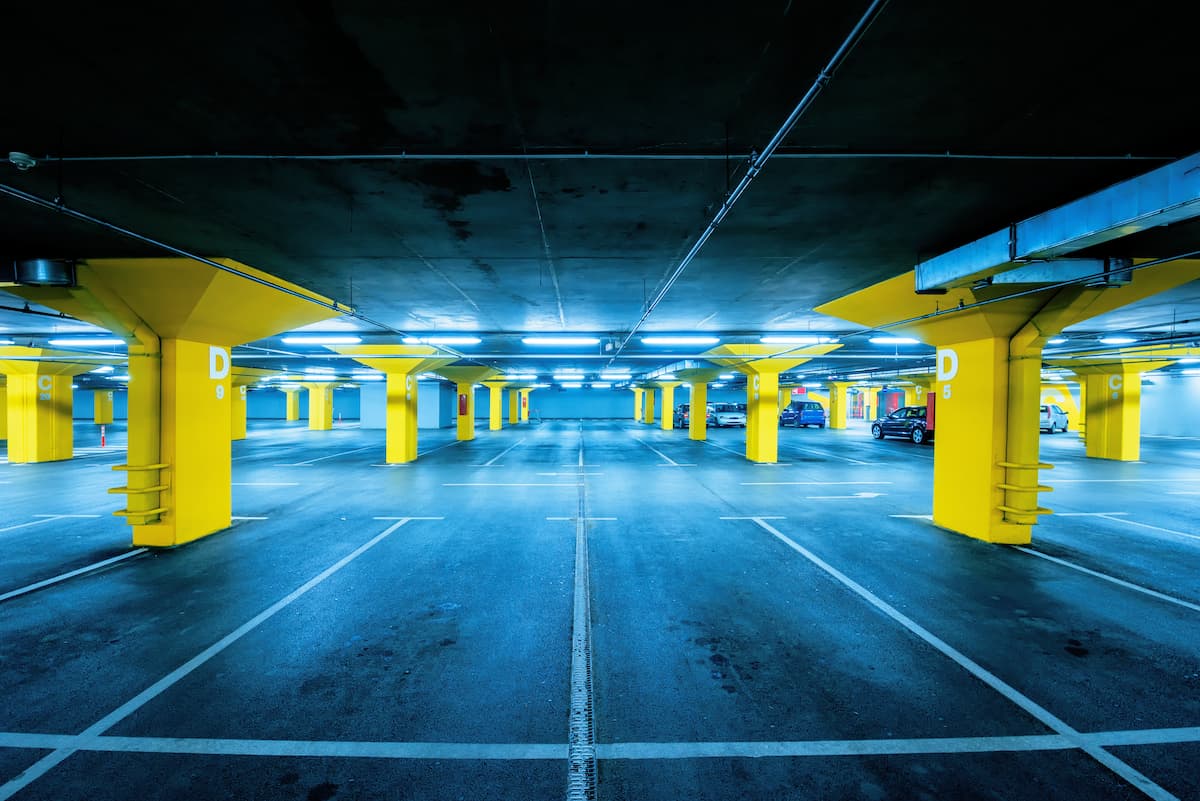In winter the UK faces increased rainfall, higher groundwater levels, and frequent surface water flooding. Garages and car parks are often the first to suffer, especially where drainage systems are blocked or thresholds are worn. Water ingress can damage vehicles, flooring, and electrical systems. It can also cause mould, structural deterioration, and business interruption. In some cases it can even cause fatalities.
At Tiger Utilities, we specialise in vacuum tanker drainage cleaning, CCTV drain inspections, and flood prevention maintenance. From small domestic garages to large commercial car parks, we’ve seen how proactive inspection and drainage upkeep stop flooding before it starts. We’re here to explain why garages and car parks flood, provide a detailed pre-winter checklist, and show when to involve drainage professionals to keep your property safe this winter.
Understanding why garages and car parks flood
Flooding in garages and car parks usually results from one or more of the following:
Surface water runoff
Poor drainage
Rising groundwater
Structural ingress.
During heavy rain, surface water flows toward low points, often entering through garage door thresholds or car-park ramps. If gutters or downpipes are blocked, overflow collects around the base of buildings, quickly finding cracks or weak seals.
Rising groundwater can also push water through floor joints or expansion cracks, especially on older properties with inadequate damp-proof membranes. Car parks, with their large impermeable surfaces, are particularly vulnerable to ponding when channel drains or gullies are blocked with silt or leaves. Once water collects, it can back up through gullies into the surface area.
Even minor design flaws can compound the issue. Poor ground grading directs runoff toward entrances rather than away. Damaged door seals or cracked concrete floors allow infiltration. In multi-storey or underground car parks, pump failure or blocked sump systems can quickly lead to extensive flooding.
By understanding these causes, property owners can target the right solutions, regular cleaning, surface water management, and proper drainage maintenance, to prevent most flood incidents.
Pre-Winter Checklist (DIY and Professional)
Before winter begins, every property owner or facilities manager should complete a thorough drainage and waterproofing inspection. Use this checklist to guide your maintenance and preparation.
Basic checks you can do yourself
- Clear all gutters, downpipes, and roof outlets of debris to ensure rainwater discharges correctly away from the building.
- Check ground levels to confirm they slope away from the garage or car park; adjust grading if water pools near thresholds.
- Inspect door seals, thresholds, and weather-stripping for cracks, warping, or gaps that could let surface water enter.
- Examine interior walls and floors for cracks, efflorescence (white salt marks), or staining that indicate previous seepage.
- Remove debris and standing water from drainage gullies, manholes, and surface channels.
- Test drainage performance by pouring water into gullies or channels and observing the flow rate.
- Move valuable tools, equipment, or vehicles away from the floor and entrance area to minimise potential water damage.
Intermediate upgrades and preventative improvements
- Replace worn door seals or install a raised flood-barrier threshold to block incoming surface water.
- Apply waterproof coatings or damp-proof sealants to concrete floors and porous masonry walls.
- Install linear trench drains across entrances or ramps to intercept runoff before it enters the building.
- Use load-rated drainage components suitable for vehicles and heavy traffic areas.
- Fit a sump and automatic pump system in locations with high groundwater or recurring damp issues.
- Test existing sump pumps and alarms to ensure they function correctly and have battery backup.
When to call in a professional
- Contact Tiger Utilities if drainage appears slow, if gullies back up, or if water is ponding despite surface cleaning.
- Arrange a CCTV drain inspection to identify hidden blockages, collapsed pipes, or misaligned joints.
- Schedule vacuum tanker cleaning to remove silt, oil, and debris from underground drains, interceptors, and car-park channels.
- Seek expert advice if water is rising through the floor slab or if the property experiences recurring dampness.
- Engage drainage professionals for large-scale solutions such as re-grading external areas, installing demountable flood barriers, or fitting non-return valves.
- For commercial sites, establish an annual maintenance contract to keep drainage and pumping systems fully operational throughout the wet season.
Design and structural solutions for higher-risk sites
Properties in known flood zones or low-lying areas may require additional structural defences. Demountable flood barriers across garage doors can hold back rising water, while permanent raised thresholds provide passive protection year-round. Non-return valves installed on drainage lines prevent stormwater or sewer backflow during intense rainfall events.
Surface water management is equally important. Creating swales, soakaways, or French drains helps divert water away from the building. Sustainable drainage systems (SuDS), recommended by the Environment Agency and CIRIA, allow gradual water infiltration and reduce runoff pressure. For underground or multi-storey car parks, internal channel drains and sump systems collect and pump away water efficiently.
To ensure long-term performance, all drainage components should be load-rated to handle vehicular traffic and resistant to chemical and oil exposure common in car parks.
Maintenance and monitoring
Flood prevention relies on consistent upkeep. Before and during winter, inspect gutters, drains, thresholds, and seals. Clear channels and gullies regularly, especially after storms or heavy leaf fall. Professional vacuum tanker cleaning is highly effective at restoring flow where silt or hydrocarbon build-up has reduced capacity.
Test sump pumps, float switches, and alarm systems every month to confirm proper operation. Install water-level sensors in pump chambers and at car-park low points for early warning. After major storms, walk the site to identify damp patches, staining, or slow-draining gullies. Quick detection allows minor issues to be corrected before they escalate.
Case study: Flood prevention in a commercial car park
A Liverpool-based multi-storey car park suffered repeated flooding during winter rainfall. Tiger Utilities conducted a CCTV drainage survey, revealing heavy silt deposits and a collapsed section of storm pipe. We used vacuum tankers to clear debris, installed new D400-rated linear drainage at the ramp entrance, and fitted non-return valves to prevent backflow. The system was connected to a dedicated sump and pump arrangement with level alarms.
Following these upgrades and a scheduled maintenance contract, the site recorded zero flood incidents during the next winter season, saving thousands of pounds in damage, insurance claims, and lost operating days.
The business case for flood prevention
Flood damage is costly and disruptive. For homeowners, a flooded garage can destroy vehicles and stored possessions. For businesses, car-park flooding creates safety hazards, service interruptions, and reputational damage. By contrast, preventive measures such as CCTV inspections, drainage cleaning, and seal replacements are inexpensive and quickly implemented.
Partnering with a specialist like us ensures long-term reliability. Our engineers use high-capacity vacuum tankers, advanced CCTV systems, and industrial pumping technology to maintain drainage infrastructure across the UK. Regular inspection and cleaning not only prevent floods but also extend the lifespan of your drainage assets.
Taking action before winter
Now is the time to act. Inspect all drainage systems, seals, and thresholds before winter rainfall begins. If you have any concerns about your garage or car park drainage, arrange a professional survey with Tiger Utilities. For larger commercial sites, booking annual cleaning and maintenance ensures compliance with environmental standards and prevents costly emergency callouts during storms.
Common myths about flooding
Many property owners assume that above-ground garages cannot flood, yet surface runoff often enters through tiny gaps. Others believe that sandbags provide sufficient protection, but these only delay water ingress temporarily. Another misconception is that drainage systems are “fit and forget”; in reality, all drains require regular inspection and cleaning. Flood prevention is not a one-time project, it’s an ongoing process of inspection, maintenance, and improvement.
About Tiger Utilities
Tiger Utilities is a UK-based drainage and utilities specialist providing nationwide services in vacuum tanker cleaning, CCTV drain inspections, and flood prevention maintenance. Our team works with homeowners, facilities managers, and local authorities to protect properties against surface water flooding and drainage failure. With over a decade of industry experience, we deliver rapid response, preventative maintenance, and tailored drainage solutions across commercial and residential sectors.
Summary
In summary, this article from Tiger Utilities explains how to prevent flooding in garages and car parks by combining simple pre-winter maintenance with professional drainage support. Regular cleaning, inspection, and sealing are the cornerstones of flood defence. More advanced measures—such as installing trench drains, non-return valves, sump pumps, and flood barriers—offer long-term protection. With proactive care and expert assistance, garages and car parks across the UK can remain dry, safe, and operational throughout the wet winter season.
Frequently Asked Questions
What causes most garage or car park floods?
Flooding is usually caused by blocked drains, poor grading, surface runoff, or failed seals that allow water ingress during heavy rain.
How often should drainage be cleaned?
Property owners should inspect and clean drains at least twice a year—once before winter and again in spring. Commercial car parks benefit from quarterly vacuum tanker cleaning.
Do flood barriers and sump pumps really help?
Yes. Flood barriers stop surface water at entry points, while sump pumps automatically remove water from low-lying areas before it causes damage.
When should I involve a professional?
If you notice slow drainage, damp walls, standing water, or recurring odours, book a CCTV drain inspection or professional cleaning service immediately.





